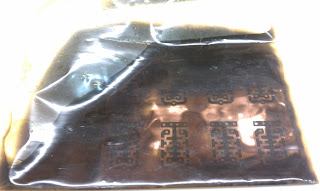It is difficult to produce Double Sided PCBs, the lack of the ability to see through the PCB material makes it is difficult to line up the second side art work with precession. Yes, it can be done using pins and holes, but I don't like the idea.
It occurred to me that if the PCB material was exactly the right size, alignment may be possible, but alas, my attempts have failed to provide the precession that I need. I do not like to have to try to cut the PCB material with that high level of precession, and Toner Transfer does not work well near the edge of the PCB material.
Then an Idea!
If common artwork extended beyond the edge of the PCB blank, it could be used for alignment of the second side art, without the need of seeing the pads through the PCB material.
So, now to try it.
I added large makeshift (or crude) Targets around the proposed artwork. As it turns out DipTrace (the PCB software that I use) does not have a Target symbol and all normal "Assembly" art includes component symbol information that over prints onto the PCB circuit layout.
So for my first attempt, I created several large PADs (250 mils) with a large holes (245 mils) and placed them around the PCB, because the pads over print each other the results looks like a clover leaf, shown at each corner of both sides of the layout. Note: this is a small board that is 1 inch wide and 2 inches long. Traces are 8 mils, with 12 mill clearance, the front side ground grid is 8 mils on 24 mil centers.
Side One and Side Two Art
Makeshift Targets
The PCB material was cut small enough to not obscure all of the Targets but yet large enough to cover the circuit.
Ready for Lamination
The results are not perfect but usable, the targets did not transfer as well as expected, this is a normal problem near the edge of the PCB material.
The alignment targets are easily usable
for alignment of the second side layout
After the first side has been etched (while the back side was covered with tape), the Targets are used to align the second side art before lamination. If not careful, the lamination process can sometimes slightly shift the art.
 Sorry, I did not take photos of the second side alignment process, here are the results after drilling holes while holding a Dremel Tool by hand (I really need to build/buy a hole drilling jig). If you look close (click to zoom in), the errors are my lack of ability to drill accurate holes by hand, and not the art work alignment problem. There a few holes (example, upper center) with good alignment on both sides.
Sorry, I did not take photos of the second side alignment process, here are the results after drilling holes while holding a Dremel Tool by hand (I really need to build/buy a hole drilling jig). If you look close (click to zoom in), the errors are my lack of ability to drill accurate holes by hand, and not the art work alignment problem. There a few holes (example, upper center) with good alignment on both sides.The second side did not print as well as expected, but I am sure that is because I did not wash or clean the second side after removing the tape used as a mask for the first etch.
The smallest of the PCB holes are "via's" which are a 40 mil pad with a 10 mil hole.
After this first experiment, Gerard Yvraut (a fellow DipTrace user) pointed out "Mounting Hole" art prints on all layers as hole art - Just the thing that is needed to make this process easier.
My next attempt will be better.
--





















